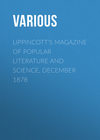Kitabı oku: «Graham's Magazine, Vol. XLI, No. 6, December 1852», sayfa 17
HOURS IN AUGUST
—
BY MRS. J. H. THOMAS
—
Softly as the star-beam slideth
From its halls of blue;
Gently – gently as it glideth
Lily bells into —
And, with kisses unimpassioned,
Greets the vestal dew —
Falls this mellow August sunlight,
Darling! upon you.
Warmly through the bending branches, —
Through the slumbrous air —
Like a thought of joy it glances
On thy forehead fair;
Softly wreathing o’er the midnight
Of thy shining hair,
Till the gleam of starry pinions
Seems to linger there.
Sweetest eyes of softened splendor
On me faintly beam;
Lips most proud, and yet most tender,
Move as in a dream;
While our boat beneath the willows
Sleeps upon the stream —
Moveless, save its idle rocking
In the golden gleam.
Hours of faint and drowsy sweetness
’Mid the silence go —
Idle hours, that care or fleetness
Scarcely seem to know; —
Lightly rest! nor dream thou, darling,
Of time’s onward flow,
Till, upon yon wall of sapphire,
Sunset banners glow.
Then, from out the brooding silence,
Softly will we glide
Past the myriad happy islands
Sleeping on the tide;
Home with joy! though hours as golden
Long must be denied,
Clasping thus their haunting sweetness
Naught we’ll ask beside.
ANNIE
—
BY D. W. BARTLETT
—
Her brow is very beautiful —
The lily’s spotless hue;
Her eyes, which ever follow me,
Are heaven’s own blue;
Like rose-buds are her little lips,
Her motions full of grace,
And spiritually clear and fair
Her innocent young face.
Her smile is sunshine to my heart,
Her silver voice a tune
I always love to hear – her breath
Like that of flowers in June;
She is my first, my only child,
And has no mother’s love
To gather closely round her heart —
She is in light above!
Her snow-white arms are round my neck.
Her lips my own do seek,
Her curls of silken, golden hair
Fall down upon my cheek;
I hear her voice and watch her eyes,
And whisper low – “above
Such voices fill the air – and there
There be such eyes of love!”
When trouble fills my aching breast
And I am grief’s sad prey,
Her prattling lips and gentle glee
Drive all the gloom away;
She lays her head upon my heart
And hushes every sigh:
I dare not think how cold the world
Would be if she should die!
THE USEFUL ARTS IN OTHER NATIONS AND TIMES
—
BY CHARLES WILLIAMS
—
For several centuries after the irruption of the Barbarians and the fall of Rome, there are scarce any visible traces of the existence of those manufactures which attained so high a development in the old world. This remark, of course, applies merely to Europe, for arts and refinement still continued uninjured in the Eastern empire; and thence, on the revival of Italian commerce, the knowledge of many inventions and useful arts flowed westward. In the ninth century, the inhabitants of the cities in Italy began to rebuild their ancient walls; and the security conferred by fortified towns, together with the union of their citizens for mutual defense, soon caused a decided advance in the useful arts. Their progress was necessarily slow, in consequence of many disturbing political and social evils. We will give a few examples from an ancient historian12 cited by Muratori, to show the condition of the most civilized country of Europe in the former half of the thirteenth century.
He mentions the barbarous dress that still prevailed – that a man and his wife ate from the same plate – that one cup sufficed for the use of a whole family – that gold or silver were rarely or never seen for ornament in dress – that war was still the glory of the men. But the more refined ecclesiastics even then contrived to gather luxuries around them, brought by reviving commerce from the East. And that at this age considerable display could be made on grand occasions, will be well shown by the account given of the French soldiers and the procession on the entry of Beatrice into Naples, A. D. 1266. The writer above quoted says, that “all of them were tastefully dressed, and wore beautiful plumes, while their chiefs were notably adorned with large golden collars; and the carriage of the queen covered with silken velvet, dyed sky-blue, and sprinkled with golden lilies.” Carriages, says the authority cited, were very rare. The “many ladies of rank, glittering with precious robes, and sitting on their richly caparisoned, ambling palfreys,” complete the view of a characteristic scene of the times. It is impossible to read such descriptions without feeling in its full force the statement of Hallam, that the revival of commerce and arts must be dated much earlier than the thirteenth century.
One of the earliest movements in this revival is to be seen in the woolen manufactures of Flanders, which were so flourishing in the thirteenth century, that a contemporary writer asserts “that all the world was clothed with English wool wrought in Flanders.” Brabant and Hainault were also the seat of the same manufacture; and the fabrics woven in the factories of the Netherlands were, doubtless, extensively diffused. We need scarcely observe, that the attainment of this perfection mast have been a work of some time.
Cologne, Bruges, Ghent, and Antwerp became centres of manufactures and commerce; whilst the origin of the Hanseatic League gave a new impulse in the north to the progress of the useful arts. In the early part of the fourteenth century a system of trading commenced between the north and south of Europe; and the free application to navigation of the discovery of the magnetic needle – a discovery made in Europe about A. D. 1200, and long unapplied – vastly increased commercial intercourse, and, as a necessary consequence, the home manufactures of nations. The Italian towns, especially Venice, Pisa, and Genoa, first raised to importance by the Crusades, took a leading part in the general movement, and became the channels through which the East poured her riches and the knowledge of her arts into Europe. The southern French provinces were not behindhand. Marseilles – where the spirit at commercial enterprise had never wholly died away – Narbonne, Nismes, and Montpellier, were all distinguished for prosperity and growing wealth. The invention of a system of banking, which we find in operation so early as 1400 A. D., deserves to be mentioned, as one of the most influential causes of the rapid growth which followed. England, indebted to her neighbors for the origin of so many of her manufactures, entered the lists late, though destined eventually to outstrip all competitors.
During the unsettled periods at which we have been glancing, agriculture was, of course, neglected; but toward the end of the thirteenth century we find that it has shared in the general revival, and that the plains of Lombardy present the appearance of one vast garden. Indeed, the prospect of Italy was then far more pleasing than that which there meets the traveler’s eye in our own times.
A few words on the progress of the art of building. The first Gothic architecture – correctly so named – appears to have arisen from an imitation of Roman remains, and the combination therewith of rude barbaric notions. The round arch still remained the predominant feature of construction; and the less finished works of this period, with their undeveloped style, deserve the name of “Gothic,” which is now generally restricted to the designation of them. In the twelfth century, however, the introduction of the pointed arch marked a new era in the art of building, and was the beginning of that skill and taste which produced the magnificent architectural monuments inherited by us from the middle ages. Clustered pillars, carved mullions, foliations, and graceful tracery, quickly followed the introduction of this new element; and the union of strength with lightness, of which the flying buttress affords a beautiful example, was carried to as high a point of perfection as the material would allow. To the introduction of the pointed arch Venice may, perhaps, lay claim; and the rise of her palaces amid the waters of the Adriatic, probably marked the origin of many other improvements in construction. One of these, which lies at the very root of modern skill in house building – we mean the framing of timber floors – may be assigned to her artificers. Houses were thenceforward built in stories, and skill in this respect soon issued in domestic works, which in utility and outward beauty surpassed the ancient dwellings. These improvements were soon adopted elsewhere, from the ninth and tenth centuries downward.
The Moorish architecture, introduced into Europe by the Arabian conquerors of Spain, early attained a high development. One singular characteristic of this style, – the horse-shoe arch – must be specially mentioned, as a new feature in construction; and its shape was, perhaps, suggestive of the dome, universal in the later Mohammedan architecture. Slender pillars, profuse decorations in painting, mosaic, and stucco, with elaborate lattice and trellis-work, and perforated battlements, so intricate as to resemble network, are the other points for remark in Moorish buildings. The polish and refinement of the Saracens distinguished them wholly from the rude barbarians of the North. They did not invade to destroy, but to improve; and so early was the development of their architecture, that one of their most splendid remains, the mosque at Cordova, was erected in the beginning of the ninth century – a period which could show nothing so beautiful elsewhere. The celebrated Alhambra – the palace of the Moorish kings of Granada – is some three centuries later, and must be alluded to here as the highest development of the luxurious Eastern style. The perfect state in which parts of this celebrated Moorish palace still remain, is elegantly thus described by a modern writer,13 in his notice of the “Court of Lions” and the surrounding halls: – “Here the hand of time has fallen the lightest, and the traces of Moorish elegance and splendor exist in almost their original brilliancy. Earthquakes have shaken the foundations of this pile, and rent its rudest towers; yet, see, not one of those slender columns has been displaced – not an arch of that light and fragile colonnade has given way; and all the fairy fretwork of these domes, apparently as unsubstantial as the crystal fabrics of a morning’s frost, yet exist, after the lapse of centuries, almost as fresh as if from the hand of the Moslem artist.”
In following the course of invention and rediscovery during the middle ages, and in subsequent times, we see two main causes of the superiority of our own useful arts to those of the ancients – the extended application of mechanical and chemical science. The discovery of the various problems in mechanics, which paved the way for the multiplication of human force, and the introduction of new motor powers, occupied chiefly the latter half of the sixteenth and the seventeenth century. The treatises of Stevinus and Galileo, with the first dawnings of the discovery of the steam-engine, appear to mark a new era, and prepare the way for those wonderful applications of moving power which have changed the face of the manufacturing world. The subsequent train of discovery is far too comprehensive for our limits, and ends at length in that crowning development of machinery – the Calculating Machine of Mr. Babbage. We need only mention that, by this extraordinary instrument, some processes of numeric and algebraic calculation may be effected, to an extent hitherto unattainable by mathematicians.
A short view of the progress of the art of clockmaking, will well illustrate a gradual advance made in the application of mechanics to the uses of daily life. Striking clocks were known in Italy probably as early as the end of the thirteenth century – one other strong proof that we must date the revival of arts much earlier than that period. Their existence becomes certain about the middle of the fourteenth; probably at that period they were general. These clocks were all moved by the action of weights; and, though furnished with balance regulators, were still very inaccurate. Next followed the introduction of a spring as the moving power, marking a new era in the art. Then came the age of mechanical discovery, producing Galileo’s observation of the vibration of the pendulum in nearly equal times, whether the spaces traveled through were large or small. So valuable a discovery could not long remain dormant; and we find, accordingly, that it was applied by the discoverer, or, in a better form, by Huyghens, to the regulation of time-pieces by means of the pendulum. The advance of chemical science soon showed a source of error in the unequal size of the pendulum, caused by alternate expansion and contraction of the metal due to change of temperature. This was remedied by the use of the jar filled with mercury as a pendulum; and subsequently by the employment of a pendulum formed of different metals, so arranged that their different expansions should mutually balance each other. The mutual connection between the art of making clocks and the science of astronomy, in which each has alternately borrowed and lent so much, is an excellent illustration of the many points in which the useful arts are brought into contact with higher provinces. The remaining improvements would fill volumes, and we cannot pretend to enter more fully into them.
In our estimate of causes at work during the middle ages, we must not forget that the alchemists exercised a very important influence. Their doctrine, that all the metals are compounds of the constituent parts of gold mingled with baser matters, which could be separated by the action of the philosopher’s stone, exercised eventually a powerful influence on the progress of arts. The long and patient research of the “adept” after this magic agent for turning all it touched to gold, though prompted by cupidity, resulted in many chemical discoveries and adaptations, and brought to light various useful products, for which, perhaps, we might long have waited, had not this strong motive been rooted in the minds of philosophers of the middle ages.
The invention of printing will be noticed elsewhere; and the comparative state of the useful arts in Europe may be estimated from their history in our own country. It remains for us here to notice, in a supplemental manner, one or two branches of art which will not be elsewhere included. By this means we shall better illustrate a subject into which we cannot pretend to enter fully.
In the preceding pages, the use of silk by the Greeks and Romans has been merely glanced at, because the tissues which they employed were strictly of foreign production. We will now shortly notice a manufacture, the history of which will illustrate many preceding remarks. Its origin must be assigned to China, where it doubtless reached a highly perfect state, before any other nations acquired an acquaintance with the mode of producing or working the raw material. It is probable that silk-worms were reared in China, and their cocoons extensively employed, 2700 years before the Christian era. The raw material subsequently was exported to Persia, Tyre, Berytus, and elsewhere, till, in our westward progress, we find the island of Cos receiving and manufacturing it. In the Augustan age silks were still rare, even in Rome, the centre of all luxuries; and so late as the third century it was deemed a display of wanton profusion for an emperor to dress entirely in silk.
In the sixth century, some Persian monks, who had penetrated into China, gained an acquaintance with the source whence silk is derived – a secret till then guarded with scrupulous care. They brought back with them to Constantinople a quantity of eggs enclosed in a hollow cane, which produced “the progenitors of all the generations of silk-worms which have since been reared in Europe and the western parts of Asia.” For nearly six hundred years, Constantinople and the territories of the Greek empire continued to monopolize the production of silken fabrics; till, in the twelfth century, the manufacture was introduced into Sicily, and thence successively into Italy, Spain, and France; until, finally, it reached England. The culture of the mulberry-tree was extensively introduced wherever the climate permitted. Bologna, Modena, Venice, Genoa, and Florence were all noted for their silk manufactures, and produced silken tissues for the rest of Europe; till, in the sixteenth century, the rearing of the worm and the weaving of silk were introduced into Lyons and the south of France, since which period the French have acquired and maintained a superiority in this branch of the useful arts. In this historical sketch we may observe many important points: – First, we see a manufacture in a stationary state of high perfection for thousands of years in the East; then follows its slow progress westward during the ages of Greece and Rome; next the loss to Italy and Europe of the bare knowledge of the material product, on the fall of the Roman empire; then the revival and cultivation of the manufacture in the metropolis of the Eastern empire; succeeded by its introduction thence into Sicily, and a rapid improvement effected by the enterprise of Italian cities; till, finally, it spread wherever circumstances were favorable. The account of any such manufacture well remembered, is a kind of epitome of the history of the time through which we mark its progress. To make the sketch true in all its parts we need only add, that a Frenchman invented a loom to make woven silks, whose patterns rival the slow produce of Eastern patience, while England has shown her accustomed superiority in the effecting by machinery of all processes required antecedent to weaving.
We have mentioned the singular manner in which the ancient Greek art of vase painting died away, without apparent cause. The reappearance of the same art early in the middle ages is due, probably, to the Moors, but whence derived by them, or whether reinvented, or how retained in the world during so many centuries, are all curious questions. But, be this as it may, the manufacture of porcelain vases, where color and enamel were carried to high perfection, with their arabesques, heraldic devices, portraits, or landscapes, and an endless variety of form, whether grotesque or tasteful, was much pursued in the fourteenth century. The beautiful Majolica vases, of which one illustration will be found standing side by side with a characteristic Moorish jar, were part of a branch of manufacture which again perished in Italy to revive elsewhere. The two vases tell each an interesting story. No one can glance for one moment at the Moorish vessel, with its singular shape and arabesque ornament, without feeling that it is the monument of a people that stood alone. As little can we regard the vase of Majolica or Raffaelle ware, without the thought of that singular coincidence in things, small as well as great, between the Italian republics and their ancient Grecian counterparts.
A short epitome of the Majolica manufacture is given as follows in a recent work: – “Small plates for ice and sweetmeats, about a palm in diameter; children’s plates, with paintings in the style of the Festa di Ballo; nuptial vases with appropriate subjects; vases for holding different kinds of wine, poured out from one spout; fiaschini, or small flasks, in the shape of lemons and apples; cups covered with tendrils and other quaint devices; small statues of saints; jocose figures; birds of every kind, colored after nature; painted tiles, used for walls and floors, many of them admirably executed, show the great variety and excellence of this ware.”14 On the decay of the art in Italy, it was revived in other forms in France and Germany. The singular accidental discovery of the art of making the hard paste porcelain, which, till the beginning of the seventeenth century, was confined to the East, will furnish one instance of the many debts due to the alchemists. A persecuted German, named Böttcher, whilst prosecuting his forbidden researches for the philosopher’s stone, unexpectedly found that some of his crucibles assumed the appearance of Oriental porcelain. Carefully noting the substances on which he had been experimenting, he worked incessantly, sometimes spending many days and nights, without a moment’s intermission, by the side of his furnace, till at length he perfected his knowledge of processes which originated the beautiful manufactures of Dresden. The secret spread through Austria and France, giving rise in the latter country to the celebrated Sèvres china; and the proscribed research in a forbidden mine terminated in the happy industry of thousands of workmen.
The progress of maritime discovery, and the new impulse given thereby to commercial and industrial progress, has been briefly noticed. But while compelled by our narrow limits to pass by, with a hasty word of mention, the enterprise which raised the Venetians and Dutch to the rank of leading powers in Europe, and which conferred the treasures of Africa and remotest India upon the Portuguese nation, the rise of the Spanish power in the new world must be noticed more fully, as opening a new and peculiar phase of civilization to our view. The singular state of society among the Aztec race at the period of the Spanish conquest of Mexico is doubly interesting, from the striking contrast which it presented to any thing in the old world; and from the fact that it shows us the highest point of a development, the progress of which no traces remain to illustrate. Suddenly transported from the stirring scenes of martial enterprise and reviving industry of Europe in the middle ages, the steel-clad Spaniard found himself among nations where the blindest and most abject superstition stood side by side with social refinement; where the prevailing mildness of manners was no bar to the dreadful orgies of human sacrifice; and where the busy industry of millions had been for ages raising the pyramid of art and science, in complete isolation from their brethren of the old world.
Various points of resemblance will be noticed by the reader between the arts of these American races and those of ancient Egypt. For instance, the pyramidal temples found by the Spaniards on their first invasion much resembled the Egyptian structures, in their form, and were constructed of solid masses of earth encased with stone or brick facing. They differed from Egyptian pyramids in being higher proportionally to the size of the base. They were ascended by external stairs, and were arranged in several stories. The area at the summit was surmounted by towers; – sanctuaries where the images of their gods were erected, and where the horrid stone for human sacrifice stood, close by the altars, on which a never-dying fire was burning.
Another point of close similarity between the Aztecs and the ancient Egyptians was seen in the employment of hieroglyphic writing, or rather painting, by both people. Their laws, their annals, their rituals, and their business documents, were all expressed by this rude representation of painted figures, often gross caricatures in their execution. “Their manuscripts were made of different materials – of cotton-cloth or skins nicely prepared; of a composition of silk and gum; but for the most part of a fine fabric from the leaves of the aloe.” A sort of paper was made from this, resembling somewhat the Egyptian papyrus, which, when properly dressed and polished, is said to have been more soft and beautiful than parchment. Some of the specimens still existing exhibit their original freshness, and the paintings on them retain their brilliancy of colors. “The large leaves were folded square like books, or done up into a roll in the ancient manner. The arrangement of the picture letters was horizontal or perpendicular, and the reading in the former case probably from right to left.”15
The cultivation of the soil was skillfully pursued by the Aztec people. Their irrigation, farm buildings, and agricultural processes, were excellent; while the large fields of maize, the banana, the cacao or chocolate plant, the useful aloe, the vanilla, and a crowd of splendid garden plants, furnished them with all necessaries and many luxuries on almost too easy terms. A description of the uses of the aloe or agave plant, from the pen of the eloquent author just cited, is highly interesting: – “Its bruised leaves afforded a paste from which paper was manufactured; its juice was fermented into an intoxicating beverage, pulque, of which the natives to this day are excessively fond; its leaves further supplied an impenetrable thatch for the more humble dwelling; thread, of which coarse stuffs were made, and strong cords, were drawn from its tough and twisted fibres; pins and needles were made of the thorns at the extremity of its leaves; and the root, when properly cooked, was converted into a palatable and nutritious food. The agave, in short, was meat, drink, clothing, and writing materials for the Aztec.”16
The Mexicans were well acquainted with the usual mining operations for procuring gold, silver, lead, and tin. Iron was unknown to them, and we find bronze fulfilling a variety of uses, just as among the ancient Greeks and Romans. Very perfect tools were made from this compound of tin and copper; vessels of gold and silver were cast and chased, some of them of an enormous size; in the working of ornamental jewelry, and in the cutting of precious stones, their artificers highly excelled. A hard mineral substance – obsidian, furnished the material for their hardest tools – their axes, knives, razors, and swords. Their sculpture still evidences skill in workmanship, though the designs may be barbarous; and the mechanical skill which could raise and transport so large a monument as a porphry stone of fifty tons weight, without the aid of beasts of burden, from a distance of many leagues, cannot have been contemptible. They employed utensils of lacquered wood or of earthenware, and in the art of pottery were so advanced, that it was said by a historical writer of Europe, “There is no fictile vessel among ourselves which in skill of construction excels the vases formed by them.” And this, too, at a time when the fictile art was at a high pitch of excellence in Europe. Cotton was raised abundantly in the suitable localities; was woven into fabrics, sometimes beautifully fine; and these in turn made into a kind of armor by thickly quilting. Or it was interwoven with the “delicate hair of rabbits and other animals, which union produced a cloth of great warmth as well as beauty, of a kind altogether original; and on this they often laid a rich embroidery of birds, flowers, or some other fanciful device.”17
The reader will remember the feather tapestry to which allusion has been made in the account of Greek and Roman art. It is singular to turn after the lapse of centuries and find this fabric in a more perfect form, and applied to an infinite variety of purposes, among a newly-discovered people, whose very existence was undreamt of by the ancient world. The gaudy plumes of the tropical birds most naturally have suggested their employment for dress or ornament, and the art of working them made so great progress as to have become a characteristic of the industry of the people. Tapestry and mantles of these materials could not be excelled, in brilliancy of hue and softness to the touch, by the most elaborate tissues of the loom.
The scenes which everywhere met the eyes of the Spanish invader denoted a state of refinement and luxury, in some points forcibly reminding us of counterparts in Eastern life. One main cause of this development was perhaps the singular contrast which Mexican society offered to that of Greece, Rome, or modern monarchies, in the fact that trade was not only honorable in itself, but a pathway to high political dignity.
The list of articles given by Mr. Prescott, as the tributes paid to the royal revenue, will furnish an epitome of many manufactures and products. “There were cotton dresses and mantles of featherwork exquisitely made; ornamented armor; vases and plates of gold; gold dust, bands, and bracelets; crystal, gilt, and varnished jars and goblets; bells, arms, and utensils of copper; reams of paper; grain, fruits, copal, amber, cochineal, cocoa, wild animals and birds, timber, lime, and mats.”18
The regularity of plan in the chief cities, which so forcibly struck the eye of the Spaniard; the solid structures of stone, often reared amid the waters of their lakes on a foundation of piles; the vast temples before described; aqueducts only second, perhaps, to those of Rome or Peru; vast solid dykes, and roads of masonry which vied in stability with those of ancient Rome, everywhere attested a high state of constructive skill; while baths, gardens, canals covered with light craft, and sculptures in an infinite variety of form, generally grotesque, may be added to the details already given of the results of Mexican civilization.
There is nothing in the old world, says Mr. Stephens, like the ruins of the cities of Central America, which he so completely explored. The pyramidal structures are not complete in themselves like those of Egypt. They form parts of a whole, have no cells in their interior, and were mostly employed as the foundations for other buildings; nor are the single stones, used for images and ornaments, to be compared in vastness of proportion to Egyptian obelisks. The conclusion arrived at by the writer above quoted is, that in these cities we are presented with “the spectacle of a people skilled in architecture, sculpture, and drawing, and, beyond doubt, other more perishable arts, and possessing the cultivation and refinement attendant upon these, not derived from the old world, but originating and growing up here, without models or masters, having a distinct, separate, independent existence; like the plants and fruits of the soil, indigenous.”19










